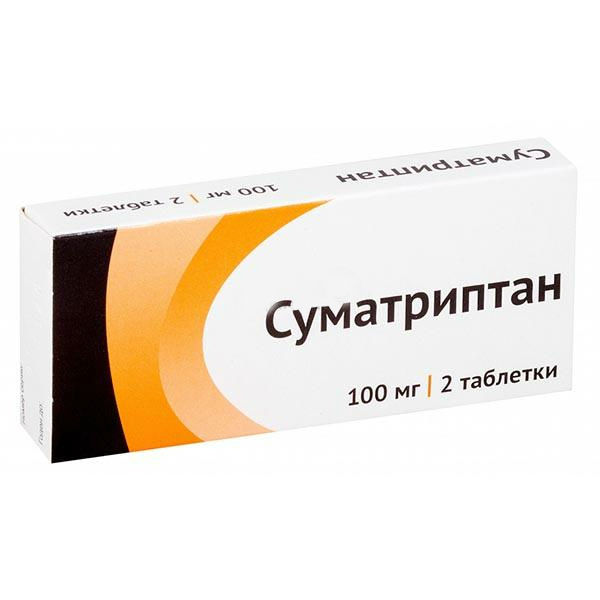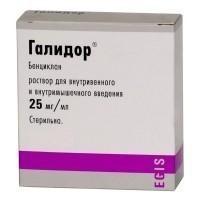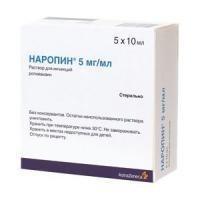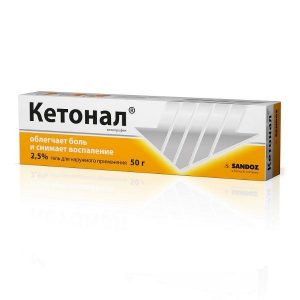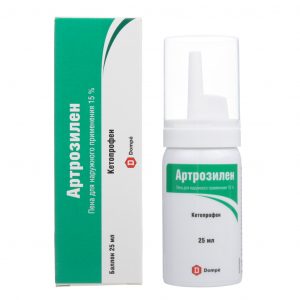Description
Pharmacological action of
Sumatriptan is a specific selective agonist of 5HT1D-serotonin receptors (5-hydroxytryptamine-1 similar) located predominantly in the blood vessels of the brain. Stimulation of 5HT1D-serotonin receptors leads to vasoconstriction. The drug does not affect other subtypes of 5HT-serotonin receptors (5HT2-5HT7).
In experimental studies, it has been shown that sumatriptan causes selective narrowing of the carotid arteries, which supply blood to extracranial and intracranial tissues, including meninges (expansion of these vessels and / or their
edema is the main mechanism for the development of migraine in humans), without having a significant effect on cerebral blood flow.
It has also been experimentally found that sumatriptan inhibits the activity of the terminal receptors of afferent trigeminal fibers. Eliminates nausea and photophobia associated with a migraine attack.
Indications
Migraine (for relieving seizures, with or without an aura).
Contraindications
Hypersensitivity to sumatriptan or other components of the
preparation hemiplegic, basilar and ophthalmoplegic forms of migraine
coronary heart disease (CHD) (including myocardial infarction, post-infarction cardiac cardiac disease)
stroke or transient cerebrovascular accident (including a history of)
occlusive peripheral vascular disease
uncontrolled arterial hypertension
severe hepatic and / or renal failure
simultaneous use with ergot alkaloids and their derivatives (including methysergide) or other tryptamines receptors MAO and the period up to 14 days after their cancellation
age up to 18 years, patients over 65 years old
lactose intolerance, lactase deficiency, glucose-galactose malabsorption.
Precautions
Epilepsy (including any condition accompanied by a decrease in the seizure threshold of anamnesis), organic brain damage, controlled arterial hypertension, impaired renal function and / or impaired liver function of mild to moderate severity, pregnancy.
Special instructions
Sumatriptan is not intended for the prevention of migraine.
Sumatriptan should be taken only if the diagnosis of migraine is not in doubt.
Sumatriptan should be used as soon as possible after a migraine attack occurs, however, the drug is equally effective at any stage of the attack. If there is no effect from the first dose, the diagnosis should be clarified.
When using sumatriptan to relieve headaches in patients with previously undiagnosed migraines or migraines with atypical symptoms, other potentially dangerous neurological diseases should be excluded. It must be borne in mind that patients with migraine have a risk of developing cerebrovascular complications (including stroke or transient disturbances in cerebral circulation).
Sumatriptan should be used with caution in case of epilepsy and any other conditions accompanied by a decrease in the seizure threshold. In case of simultaneous use with SSRIs / SSRIs, the patient’s condition should be carefully monitored.
Before using sumatriptan in patients, the presence of cardiovascular disease should be excluded, especially in patients at risk. Such patients include postmenopausal women, men over the age of 40, and patients with risk factors for the development of CHD.
The examination does not always reveal a cardiovascular disease in some patients. In very rare cases, transient side effects such as pain and chest tightness may occur after taking sumatriptan. The pain can be intense and radiating to the neck (pharynx). If there is reason to believe that these symptoms may be a manifestation of IHD, it is necessary to stop taking the drug and make a diagnostic examination.
Caution is advised in treating with sumatriptan in patients with controlled hypertension, as in some cases there may be an increase in blood pressure and peripheral vascular resistance.
Sumatriptan should be used with caution in patients with diseases in which a significant change in the absorption, metabolism or excretion of sumatriptan is possible, for example, with impaired renal or hepatic function. In patients with hypersensitivity to sulfonamides, the use of sumatriptan may develop allergic reactions that range from skin manifestations to anaphylactic shock.
Cross-sensitivity data are limited, but caution is needed when using sumatriptan in these patients.
Overuse of drugs designed to relieve migraine attacks is associated with increased headaches in sensitive patients (headache associated with drug abuse).
In this case, consider discontinuing the drug.
Influence on the ability to drive vehicles and control the technique
With migraine, as well as with therapy with sumatriptan, drowsiness may develop. Therefore, during the use of sumatriptan, care must be taken when driving vehicles and engaging in other potentially hazardous activities that require an increased concentration of attention and speed of psychomotor reactions.
Composition of
One tablet 100 mg contains:
active substance:
sumatriptan (sumatriptan succinate) 100.00 mg (140.00 mg)
excipients:
lactose monohydrate 140.00 mg,
sodium croscar ,
microcrystalline cellulose 13.50 mg,
silicon dioxide colloidal 0.50 mg,
magnesium stearate 3.00 mg
shell Opadry II 33G28707 white (hypromellose (E 464) 4.0000 mg,
titanium dioxide (E 171) 2 , 4000 mg,
lactose monohydrate 2.2000 mg,
macrogol-3000 0.8000 mg,
triacetin 0.6000 mg).
Dosage and administration
Inside (the tablet is swallowed whole with water). The initial single dose of 50 mg, if necessary, the dose can be increased to 100 mg.
If the symptoms of migraine do not disappear and do not decrease after taking the first dose, then the second dose is not prescribed to stop the ongoing attack.
To stop subsequent seizures (if symptoms decrease or disappear, and then resume), you can take a second dose over the next 24 hours, provided that the interval between doses is at least 2 hours. The maximum daily dose for oral administration is 300 mg.
Side effects
The frequency of side effects is classified according to the recommendations of the World Health Organization:
very often – at least 10%
often – at least 1%, but less than 10%
infrequently – at least 0.1%, but less than 1%
rarely – not less than 0.01%, but less than 0.1%
very rarely – less than 0.01% (including isolated cases).
From the cardiovascular system:
is very rare – bradycardia, tachycardia, arrhythmia, transient increase in blood pressure (BP) (immediately after the start of treatment), transient signs of myocardial ischemia on an electrocardiogram, coronary spasm, myocardial infarction, Raynaud’s syndrome, decreased blood pressure, flushes of blood to the face .
From the respiratory system:
is often shortness of breath, transient irritation of the mucous membrane, or burning sensation in the nasal cavity or throat.
From the digestive system:
often – nausea, vomiting, a slight increase in the activity of “liver”
enzymes is very rare – ischemic colitis, diarrhea, a feeling of discomfort in the abdomen.
From the nervous system:
often – dizziness, drowsiness, impaired sensitivity, including paresthesia,
hypesthesia is very rare – convulsions (usually with a history of seizures)
unknown frequency – tremor, dystonia, anxiety.
From the side of the organ of vision:
infrequently – diplopia, flickering of flies in front of the eyes, nystagmus, scotoma, decreased visual acuity
is very rare – partial transient loss of vision (it should be borne in mind that visual impairment may be associated with the attack of migraine itself) .
From the musculoskeletal system:
often – myalgia
unknown frequency – stiff neck, arthralgia.
Allergic reactions:
is very rare – skin rash, urticaria, pruritus, erythema, anaphylaxis.
Other:
often – pain, tingling, feeling hot, feeling weak and / or tired, nosebleeds, a feeling of compression or heaviness (these symptoms are usually transient, but can be intense and occur in any part of the body, including the chest and neck)
unknown frequency – excessive sweating.
Drug Interactions
Sumatriptan does not interact with propranolol, flunarizine, pisotifen, and ethanol. The simultaneous use of sumatriptan with ergot alkaloids and their derivatives (including methysergide) or other triptans / agonists of 5HT1-serotonin receptors is associated with an increased risk of prolonged vascular spasm and ischemia.
Sumatriptan can be used no earlier than 24 hours after taking ergot alkaloids and their derivatives or other triptans / agonists of 5HT1 serotonin receptors, in turn, preparations containing ergot alkaloids can be taken no earlier than 6 hours after taking sumatriptan , other triptans / agonists of 5HT1-serotonin receptors can be taken no earlier than 24 hours after taking sumatriptan.
Perhaps the interaction between sumatriptan and MAO inhibitors, their simultaneous use is contraindicated.
There are very rare reports from post-marketing observation about the development of serotonin syndrome (including mental disorders, autonomic lability and neuromuscular disturbances) while using sumatriptan with selective serotonin reuptake inhibitors (SSRIs).
The development of serotonin syndrome has also been reported with the simultaneous use of triptans with selective serotonin and noradrenaline reuptake inhibitors (SSRIs).
Single reports have been received of a more pronounced manifestation of adverse reactions from sumatriptan when used simultaneously with herbal preparations containing St. John’s wort perforated.
Overdose of
With a single subcutaneous injection of 12 mg, sumatriptan did not cause any side effects. When administered subcutaneously at a dose of more than 16 mg or when ingested more than 400 mg, sumatriptan did not cause any unforeseen side effects, other than those listed above.
Treatment: gastric lavage, intake of activated carbon, monitoring the condition of patients for at least 10 hours, if necessary, symptomatic therapy. There is no data on the effect of hemodialysis and peritonial dialysis on the plasma concentration of sumatriptan.
Storage conditions
At a temperature not exceeding 25 ° C.
Keep out of the reach of children.
Expiration
3 years.
Do not use after the expiry date!
Terms of delivery from
pharmacies Prescription
Dosage form
tablet
